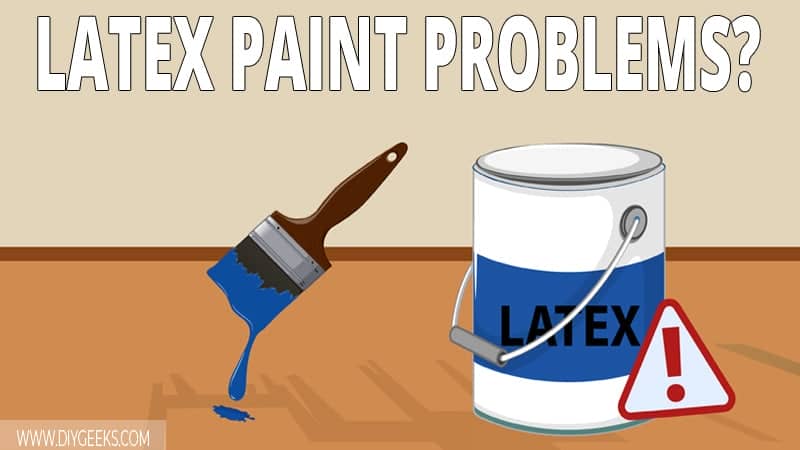Latex paint is water-based, easy to apply, colorful, and dries fast. But, sometimes, you will face different problems before, during, and after applying the paint.
The main latex paint problems are the following.
- Peeling Latex Paint.
- Bubbled Latex Paint.
- Sticky Latex Paint.
- Cracked Latex Paint.
How to Fix Peeling Latex Paint?
To fix peeling latex paint, do the following things.
- Scrape off the finish from the surface.
- Find out what caused the finish to peel; either moisture, dirt, or an existing finish.
- Sand the surface with medium and fine-grit sandpaper to remove dirt and gloss.
- Apply two coats of stain-blocking water-based primer and leave to dry.
- Wipe the primer coating when it gets dry to remove dust nibs.
- Re-apply the latex paint.
Latex paint will peel off if the surface is poorly prepped before applying it or if you apply it over oil-based paint.
- The Surface is Wet
A wet surface will prevent latex paint from adhering (or sticking) properly which results in the finish peeling off. The surface must be fully dry before applying paint over it.
- The Surface is Filthy
Filth, dust, and dirt will prevent latex paint from penetrating the surface and sticking over it. Ensure the surface is clean before applying paint.
- Painting Over Oil-based Paint
Don’t apply latex paint over oil-based paint as it won’t stick because the oil-based paint has a glossy finish that prevents penetration.
How to Fix Latex Paint Bubbles?
To fix dry latex paint bubbles, sand the surface with fine-grit sandpaper, and apply another paint coat. You can also remove the entire finish, sand the surface, apply sanding sealer, and re-apply the paint.
To prevent bubbles in latex paint, apply a sealer, primer, or wood filler over the porous surface to cover holes and pores before applying the paint.
The reasons why latex paint bubbles appear are listed below.
1. Stirring Too Hard
Stirring (or mixing) latex paint with paint thinner (water) too much will cause air pockets to trap in the coating which leads to a bubbled finish.
2. Porous Surface
A latex paint finish may develop bubbles if you apply it over a fresh highly porous surface. Highly fresh porous surfaces are riddled with large pores that have air trapped inside. The trapped air will cause bubbles in the finish after you apply the paint.
To avoid this, seal the highly porous surface with a sanding sealer, washcoat, or stain-blocking primer.
2. Moisture
Latex paint will develop bubbles if it’s applied over wet surfaces. The moisture will cause the finish to soak and tear in some parts, allowing air to get underneath the coating and develop (create) bubbles.
How to Fix Sticky Latex Paint?
To fix sticky latex paint, do the following things.
- Remove excess paint from the surface and allow the remaining to dry.
- Turn on the heater around the coating.
- Increase the room temperature.
- Use a hairdryer over the latex paint coating every 15 minutes.
- Turn on the dehumidifier to reduce the moisture in the air.
- If you can, move the painted surface outside when the sun is out.
Latex paint will naturally turn stick or tacky immediately after applying it, but if the coating remains sticky for more than three (3) hours there’s something wrong with the paint or surface.
Latex paint turns sticky for the following reasons.
1. Solvent isn’t Evaporating.
Latex paint turns sticky if its solvent (water) doesn’t evaporate from the coating. Increase the evaporation rate by exposing the coating to increased heat to speed up the drying time of paint.
2. Because of Cold Temperature.
Latex paint must be applied when the room temperature is higher than 50°F (10°C). If the temperature is lower than 50°F (10°C), the paint won’t dry properly because the humidity levels are high and will prevent the solvent from evaporating fast.
3. You Applied Paint over Wet Surfaces.
Latex paint must be applied over fully dry and clean surfaces. If the surface is wet, the moisture will prevent the paint from sticking and the solvent from penetrating, leading to a sticky finish.
4. Re-coated Too Soon.
Latex paint takes around 3 hours to dry between coats, if you re-coat it too soon, the finish will turn sticky.
5. Thick Coats.
Thick latex paint coats take longer to dry, so the coating remains sticky (or wet) for longer. In this case, the paint will eventually dry but it will take longer than usual.
How To Fix Latex Paint Cracking?
To fix latex paint cracking, do the following things.
- Sand the finish with medium-grit sandpaper (100-grit).
- Apply 1-2 coats of paint primer.
- Sand the primer coating with fine-grit sandpaper (220-grit).
- Apply 1-2 coats of latex paint.
If the latex paint cracks are too large or if water has penetrated underneath the coating, remove the entire finish, apply a stain-blocking primer, and re-apply the paint.
The latex paint finish will crack if the paint dries too fast as the paint particles won’t have enough time to bond naturally so their bond is weak. The cracks in the finish allow air and water to get underneath the coating and increase the cracks.


